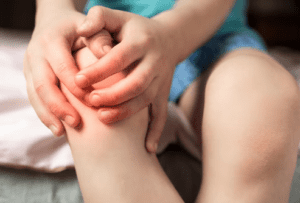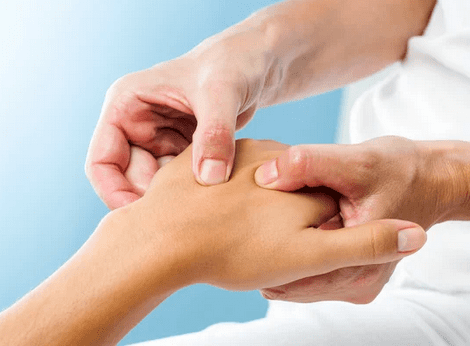Rheumatoid arthritis is a chronic battle against inflammation and pain. As an autoimmune disorder, it challenges the body’s joints, leading to discomfort and sometimes even deformity. Beyond medications, many seek holistic relief, and massage therapy has emerged as a promising ally. This post delves into the best types of massage for rheumatoid arthritis, guiding patients toward non-invasive relief options. If you want to understand the interplay between Massage and rheumatoid arthritis better, you’re in the right place.
The Benefits of Massage Therapy for Rheumatoid Arthritis
Table of Contents
- 1 The Benefits of Massage Therapy for Rheumatoid Arthritis
- 2 Best Types of Massage Suitable for Rheumatoid Arthritis
- 3 Complementary Therapies to Consider
- 4 FAQs about Massage Therapy for Rheumatoid Arthritis
- 4.1 1. What role does therapeutic touch play in managing rheumatoid arthritis symptoms?
- 4.2 2. Are there specific massage techniques that are particularly beneficial for rheumatoid arthritis?
- 4.3 3. How can one ensure safety first during a massage session for rheumatoid arthritis?
- 4.4 4. With wellness routines becoming popular, how does hydrotherapy complement Massage for rheumatoid arthritis relief?
- 4.5 5. Besides Massage, are there other alternative treatments worth exploring for rheumatoid arthritis?
- 5 Conclusion
Massage therapy, often seen as a luxury or merely a tool for relaxation, holds therapeutic potential for many health issues. For those with Rheumatoid Arthritis , embracing therapeutic touch can significantly reduce daily discomfort and a surge in overall well-being.
General Benefits of Massage:
- Stress Relief: One of the universal advantages of Massage is its ability to instill calm and reduce stress. Chronic illnesses like RA, can elevate stress levels, making Massage an attractive option for simultaneous physical and emotional relief. This process is largely due to the endorphin release accompanying a good massage session. Endorphins, often termed ‘feel-good hormones,’ combat stress and create euphoria.
- Improved Circulation: Through varied massage techniques, especially those involving gliding strokes, blood flow is enhanced, promoting better circulation. This is essential for Rheumatoid Arthritis sufferers, as improved circulation can aid in reducing joint inflammation and pain.
- Relaxation: Beyond just stress relief, massages usher in deep relaxation. This revitalizes the body and promotes better sleep, a crucial aspect for Rheumatoid Arthritis patients who often grapple with sleep disturbances due to pain.
Specific Benefits for Rheumatoid Arthritis Patients:
- Reduced Joint Pain: By targeting the areas around inflamed joints, Massage can offer natural pain relief. The therapeutic touch helps loosen tightened muscles around affected joints, which can reduce pain.
- Increased Mobility: Regular massage sessions can increase mobility for RA patients. As the surrounding muscles relax and inflammation decreases, the range of motion can be enhanced.
- Decreased Stiffness: Morning stiffness is a common symptom among RA patients. This stiffness can be diminished through consistent massage therapy, allowing for a smoother start to the day.
When embracing Massage as part of an Rheumatoid Arthritis management routine, it’s more than just about the therapeutic touch. It’s about reclaiming a sense of normalcy, enhancing bodily functions, and leveraging the body’s mechanisms, like endorphin release, for improved health.
Best Types of Massage Suitable for Rheumatoid Arthritis

Selecting the right kind of Massage is vital for maximizing its benefits, especially for individuals with rheumatoid arthritis. Different massage techniques target varied aspects of well-being, from relaxation to pain relief. Let’s explore some of the most recommended types:
1. Swedish Massage
Originating from Sweden, this massage technique is renowned for its relaxation benefits and involves kneading, tapping, and long gliding strokes.
- Characteristics and Techniques: Swedish Massage combines long gliding strokes, kneading, friction, tapping, and gentle stretching. It’s typically considered a full-body massage, targeting major muscle groups.
- Benefits for Rheumatoid Arthritis: Due to its gentleness, Swedish Massage is ideal for rheumatoid arthritis patients. It helps improve circulation, thanks to the relaxation massage techniques, and reduces muscle tension around inflamed joints. The light pressure ensures that sensitive or swollen areas aren’t further aggravated.
2. Hot Stone Massage
A hot stone massage is as therapeutic as it is luxurious. It involves the use of heated stones to massage and relax the body.
- Characteristics and Techniques: Smooth, flat stones are heated and placed on specific body parts. The therapist might also hold the stones and use them to massage certain areas, providing heat and pressure.
- Benefits for Rheumatoid Arthritis: The warmth from the stones helps ease muscle tension, making it easier to target deeper layers of muscle without excessive pressure. For rheumatoid arthritis patients, this warmth therapy relieves joint stiffness and promotes overall relaxation.
Read: How to Massage Someone with Rheumatoid Arthritis
3. Myofascial Release
This technique releases tension in the fascia – the connective tissue surrounding muscles, bones, and organs.
- Characteristics and Techniques: The therapist targets fascia, identifying areas of restriction or tightness and applying gentle pressure to release them. The motions are slow, ensuring that the tissue restrictions are adequately addressed.
- Benefits of Rheumatoid Arthritis: Rheumatoid arthritis can affect more than just the joints; the surrounding tissues can also become tense or restricted. Myofascial release can relieve this tension, offering pain alleviation around affected areas.
4. Reflexology
While not a full-body massage, Reflexology is a targeted technique focusing primarily on the feet (and sometimes hands).
- Characteristics and Techniques: By pressing specific pressure points on the feet, Reflexology believes in channeling energy and promoting healing in corresponding body parts.
- Benefits for Rheumatoid Arthritis: Reflexology can offer a unique approach to pain management by targeting pressure points related to joint pain. It’s not just a foot massage; it’s a tool for balancing the body’s energy and promoting self-healing.
Incorporating Massage into a rheumatoid arthritis management routine requires careful consideration of the individual’s pain levels, areas of inflammation, and personal preferences. With the right technique and a qualified therapist, Massage can provide relief and a renewed sense of vitality.
Read: Massage Chair for Fibromyalgia
Complementary Therapies to Consider
Rheumatoid arthritis, with its complex nature, often requires a multifaceted approach to management. While massage therapy provides significant relief, it can be even more beneficial when combined with other complementary therapies. These alternative treatments focus on alleviating symptoms and enhancing overall well-being. Here are some complementary therapies that rheumatoid arthritis patients might consider integrating into their holistic approach:
- Acupuncture: This ancient Chinese therapy involves inserting thin needles into specific points on the body. The goal is to rebalance the body’s energy and promote natural healing. For rheumatoid arthritis patients, acupuncture can relieve pain and reduce inflammation. It’s a testament to how the body’s energy balance can be harnessed for therapeutic benefits.
- Physical Therapy: Tailored exercise regimes can make a difference for those with rheumatoid arthritis. Physical therapists, equipped with a deep understanding of musculoskeletal health, can guide patients through exercises that strengthen muscles, enhance joint flexibility, and reduce pain. Think of it as an alternative treatment that emphasizes movement and strength.
- Hydrotherapy: Using water for therapeutic purposes, hydrotherapy can be a gentle way for rheumatoid arthritis patients to exercise and relax. The buoyancy of water reduces the impact on joints, allowing for pain-free movement. Activities like water aerobics or walking in a pool can promote joint flexibility and muscle strength. Hydrotherapy combines the therapeutic nature of water with structured wellness routines to offer a unique avenue for relief.
Exploring complementary therapies can provide rheumatoid arthritis patients with a more comprehensive and holistic care plan. It’s not about replacing traditional treatments but enhancing them, offering a broader spectrum of relief options.
Read: Effective Theragun Use for Sciatica Relief
FAQs about Massage Therapy for Rheumatoid Arthritis
1. What role does therapeutic touch play in managing rheumatoid arthritis symptoms?
Therapeutic touch, or the intentional manipulation of soft tissue by trained massage therapists, can be crucial in relieving those with rheumatoid arthritis. Beyond relaxation, therapeutic touch helps improve circulation, reduce muscle tension around inflamed joints, and even release feel-good hormones called endorphins. The result? A natural pain relief avenue for those contending with the everyday challenges of rheumatoid arthritis.
2. Are there specific massage techniques that are particularly beneficial for rheumatoid arthritis?
Yes, there are several massage techniques tailored to the needs of rheumatoid arthritis patients. With its light pressure and long gliding strokes, Swedish Massage is a popular choice due to its focus on relaxation and circulation enhancement. Hot stone massage, combining warmth therapy with massage techniques, can significantly relieve joint stiffness. Additionally, myofascial release targets tissue restrictions, ensuring comprehensive care for the areas around inflamed joints.
3. How can one ensure safety first during a massage session for rheumatoid arthritis?
Prioritizing safety during a massage session involves multiple steps. Choosing a therapist with proper credentials and experience in treating chronic conditions is essential. Communicating any pain, discomfort, or sensitive areas is paramount. Patients should also be aware of their body’s limits, avoiding massages during flare-ups and being attuned to any signals of discomfort or pain during a session.
4. With wellness routines becoming popular, how does hydrotherapy complement Massage for rheumatoid arthritis relief?
Hydrotherapy, a wellness routine, uses water’s therapeutic properties to offer relief. For rheumatoid arthritis patients, the buoyancy of water minimizes impact on joints, allowing for gentler exercises. When combined with massage therapy, hydrotherapy offers a dual approach, Massage focuses on direct manipulation of tissues, while hydrotherapy provides an opportunity for low-impact exercise and relaxation. Together, they can significantly enhance joint flexibility and muscle strength.
5. Besides Massage, are there other alternative treatments worth exploring for rheumatoid arthritis?
Definitely! The journey with rheumatoid arthritis often involves exploring various alternative treatments. Acupuncture, focusing on re-balancing the body’s energy, has shown promise in reducing inflammation and pain. Physical therapy, tailored to the individual’s needs, can help enhance mobility and reduce pain. The key is to find a combination of therapies that offers holistic relief and complements traditional medical treatments.
Conclusion
Rheumatoid arthritis presents unique challenges, but relief and a return to daily comfort are attainable with the right approaches. Massage therapy, backed by its myriad of benefits, emerges as a promising avenue for those seeking holistic relief. The potential for well-rounded care and management multiplies when paired with complementary therapies like acupuncture, physical therapy, and hydrotherapy. As always, it’s crucial to be in tune with one’s body, communicate openly with therapists, and prioritize well-being. Here’s to finding solace in therapeutic touch and broadening our horizons to embrace the many tools at our disposal in our journey with rheumatoid arthritis.

